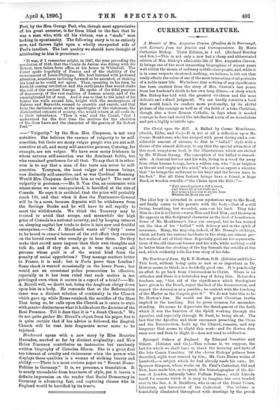Episcopal Palaces of England. By Edmund Venables and Others. (Isbister
and Co.)—This volume is, we suppose, the last for which we shall- have to thank the learning and taste of the late Canon Venables. Of the eleven Bishops' palaces here described, eight were treated by him; Mr. Cave Brown writes of Lambeth,—a subject which he had already made his own ; Dr. Sparrow Simpson, whose works on St. Paul's Cathedral, Old and New, have made him, so to speak, the historiographer of the dio- cese of London, naturally takes Fulham Palace;. while Lincoln itself, for reasons which it is easy to imagine, has oeen handed over to the Rev. A. R. Maddison, who is one of the Priest Vicars, Librarian, and Succentor of the Cathedral. The volume is beautifully illustrated throughout with drawings by the pencil
of Mr. Alexander Ansted. The interest of the subject, or rather subjects, dealt with in these papers it would be difficult to exag- gerate. To take Bishopsthorpe, as being probably less known than Lambeth, how significant the first fact recorded of it by its historian ! At every vacancy of the See, the house reverts to the Dean and Chapter. Its first builder, Archbishop Gray, 1216 55, gave it to them on the condition that they should hand it over to tl3 new Archbishop in consideration of an annual payment of 20 marks. It was true that, so far as this was con- cerned, Archbishop Gray defeated the greed of the Kings, accustomed as they were to keep sees vacant for years in order to divert the revenue into their own exchequer. Two hundred years later, Thomas of Rotherham, second founder of Lincoln College, largely increased the accommodation. In the Common- wealth time, Colonel Walter White bought it for £525 7s. 6d., and left the banqueting hall a ruin, and desecrated the chapel. But Restoration prelates added and altered, the worst changes being made by Archbishop Drummond (1761-1767). The history of Bishopsthorpe is chiefly social ; that of Farnham is largely political. Henry de Blois, younger brother of King Stephen, largely increased its strength—it had then been a possession of the See for three centuries. Prince Lewis, summoned by the Barons in their war against John, took possession of it ; in the next reign Peter des Roches added to its strength. The Bishops who inhabited it for the next three centuries were almost without exception statesmen. Few palaces have a record so interesting, but all are worthy of memorial What a work it would be if that should include all the dwellings that have been attached to English sees, to Canterbury, for instance, or to Lincoln, when it ^tretched from the Humber to the Thames !



































 Previous page
Previous page